Nose is the most prominent part of the face. An attractive nose can overshadow host of other features in our appearance. Maurice Cottle quotes “Nasal surgery involves both function and aesthetics” [1].
Even in patients with no functional problems, septal surgery forms the basis for obtaining a proper realignment of the nasal framework. Therefore, the septum deserves attention not only for functional, but also for aesthetic surgery [2].
Septoplasty is a very common nasal surgery done to correct deviated nasal septum. Various indications for the procedure are nasal obstruction, post nasal discharge, epistaxis, snoring and sleep apnoea and as a part of septorhinoplasty. [3]. Most common complication of Submucous Resection being saddle nose, ptosis of nasal tip and columellar retraction may also happen post septoplasty.
“ROUND ABOUT technique” re-explores the new dimension in septoplasty, addressing the anterior nasal spine where the quadrilateral cartilage of the septum sits [3]. In this method a semi-hexagonal incision, instead of straight Freer’s incision is taken over the mucocutaneous cartilaginous junction of the septum parallel to the caudal edge. In this technique, the opposite side of the septum is accessed without transecting the quadrilateral cartilage and both the sides of the mucoperichondrial and mucoperiosteal flaps are elevated. As there is no transection of cartilage to access the opposite side there is no weakening of the cartilage, thus the stiffness of the cartilage and the tip integrity is maintained. Hence, the name “round about” as we go all around the caudal cartilage elevating the flaps and not through it. Also, the semi-hexagonal incision helps in preserving the majority of the superior and anterior caudal parts of the cartilage avoiding tip deformity. It not only gives us an easy access to the anterior nasal spine but also helps correction of anterior caudal dislocation of septum. The chance of septal perforation is minimized as there is bilateral elevation of the mucoperichondrial and mucoperiosteal layers [4].
Materials and Methods
The study included 35 patients with deviated nasal septum and variable degree of nasal obstruction hospitalized from January 2015 to June 2015 in the ENT & Head and Neck surgery department. Patients below 18 year of age, patients with septal perforation or traumatic septal deformity, patients with chronic rhinosinusitis, nasal polyps or nasal mass were not included in the study.
Each patient was subjected to the following:
Full history taking, history of obstruction, previous nasal operations and history of allergic rhinitis, consent for the procedure were taken.
External nose examination; the deviations were classified according to the level of deformity into bony, cartilaginous or mixed. Anterior caudal deviation, septal spur, height of nasal tip both pre-operatively and post-operatively was evaluated.
Internal nasal evaluation was done with 0° and 30°nasal endoscope, thorough evaluation of the nasal septum, presence of acute spur, turbinate’s, nasal mucosa, nasal valve areas examined by Cottles and Modified Cottles test.
Sino Nasal Outcome Test-22 (SNOT -22) Questionnaire was used pre-operatively and after 3 months of surgery.
All patients were operated on using the “Round about” technique and the intraoperative findings were carefully documented and recorded. The post-operative follow-up period ranged from 3 to 6 months (mean= 4.5 months) during which time, periodic clinical examination and photographic documentation were performed to evaluate the functional and aesthetic outcomes of the performed procedure.
Nasal decongestion was done with pledgets soaked in 4% xylocaine + 1:10000 of Adrenaline. After several minutes the pledgets were removed. A 2% Xylociane with 1:200000 Adrenaline was injected in submucoperichondrial and submucoperiosteal planes bilaterally. A semi-hexagonal incision [Table/Fig-1] was made usually on the side with prominent spur which was continued as “L Shaped” incision, if required. The incision was made on the mucocutaneous junction parallel to the caudal edge of septum, instead of the traditional straight Freer’s incision and intended transcartilaginous incision. The mucoperichondrial and mucoperiosteal flaps were elevated slowly, avoiding any tear, with the help of sharp cutting scissors. The mucoperichondrial layer was elevated in the retrograde fashion from posterior to anterior direction and then anterior to posterior direction, thus creating a pocket in the medial columella and reaching the other side of the septum without transecting the cartilage [Table/Fig-2]. The opposite side of the septum was reached and the mucoperichondrial and mucoperiosteal layer was also elevated carefully. Thus bilateral elevation of the mucoperichondrial and mucoperiosteal flap was achieved. Once both flaps had been completely elevated, the deviated part of the septum (mostly the inferior strip of the quadrangular cartilage) was cut and removed with the scissors. The cartilage was preserved to later replace it back after reshaping it. Using the scissors the deviated part of the bony septum was cut and separated from its attachment and removed with Patterson’s forceps. If the deviation involved the maxillary crest, the mucosa was elevated along the floor of the nose and the crest was removed with a chisel and hammer.
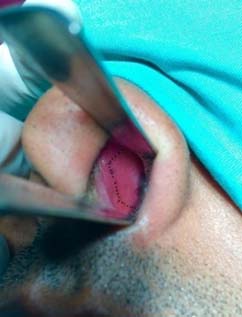
Bilateral elevation of flaps.
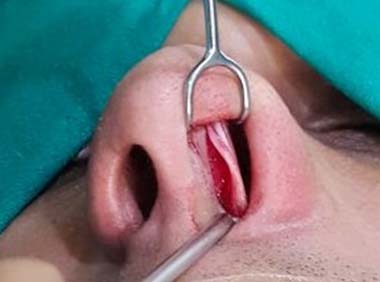
The Round About technique aids in accessing the anterior nasal spine: Addressing the anterior nasal spine [Table/Fig-3] is vital and necessary. If the anterior nasal spine is deviated, it can be fractured [Table/Fig-4] and repositioned in the center [Table/Fig-5] and the soft tissue of the nose can be sutured to the nasal spine, though care must be taken not to remove the spine.
Addressing the Anterior nasal spine.
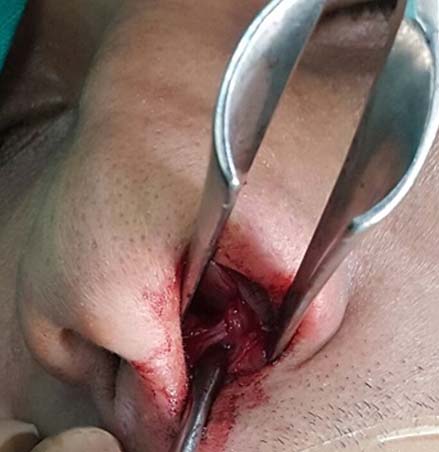
Fracturing deviated nasal spine.
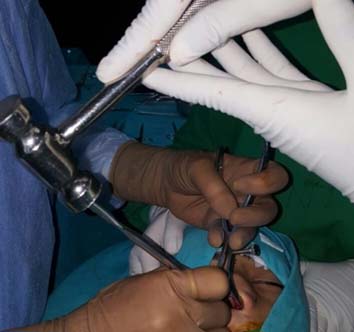
Repositioning the deviated nasal spine.
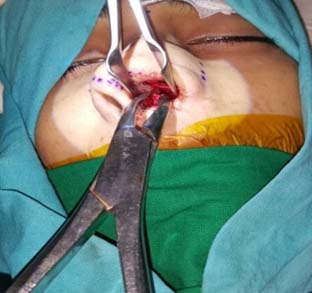
Once the entire deviation has been removed, it is recommended to replace the cartilage and bone the way they were in their place after reshaping it. Both the flaps are reposited in place and a figure of eight stitch [5] made with 4-0 Public Distribution Shop(PDS) sutures. In cases with inferior turbinate hypertrophy, turbinoplasty was done. In case of septoplasty bilateral nasal packing was done with abundant Framycetin ointment was injected with the help of a syringe and intravenous cannula attached to it and Netcell/Merocel were inserted which were kept in place for 24 hours.
Similarly if a patient had a sharp acute spur on one side, an alternative ‘L shaped’ incision was taken, similar to the semi-hexagonal incision which was extended posteroinferiorly parallel to the floor of the nose. Elevating the mucoperichondrial flap superiorly and inferiorly, the spur was dealt with ease. Later, the flap was reposited and sutured with 4-0 PDS. The advantage being, in a case of acute sharp spur with the traditional method, tearing of the flap is almost inevitable and the tear is in Zigzag fashion which is difficult to suture and if not sutured is vulnerable to trauma later. Whereas a linear cut over the flap can be sutured back in place, thus maintaining the strength and support of the septal cartilage.
Results
The male: female ratio was 3:2 and the age ranged from18 to 45 years. [Table/Fig-6] shows the number of patients with septal deviation and associated ailments.
Other ailments with deviation.
| Other ailments with deviation | No. of patients |
|---|
| Anterior Caudal Deviation (ACD) | 8 |
| Acute septal spur | 5 |
| ACD + septal spur | 3 |
| Only septal deviation | 19 |
[Table/Fig-7] shows the number of patients with non-central anterior nasal spine requiring correction 42%.
| Site of deviation | No. of patients |
|---|
| Only cartilaginous deviation | 9 |
| Only bony deviation | 2 |
| Mixed bony cartilaginous | 24 |
| Non central Nasal spine | 15 |
Variable degrees of nasal obstruction were present in all the patients; this was mainly a result of deviated nasal septum (85%), nasal valve problems (45%), inferior turbinate hypertrophy (35%) and septal spurs (15%). Sino Nasal Outcome Test-22 (SNOT-22) Questionnaire was used pre-operatively and after 3 months of surgery the scores were documented and there was a significant improvement seen post operatively after 3 and 6 months. To assess the statistical outcome Paired T-test was applied. Mean SNOT-22 scores decreased significantly from 40.02 pre-operatively to 18.65, 3 months after surgery. The results sustained after 6 months (<0.0001). 85 percent of the patients with pre-operative nasal obstruction reported improved breathing & none of the patients contracted any aesthetic criticisms or post-operative complications like septal perforation, septal haematoma, septal abscess, synechiae formation or any other major anaesthetic complications.
Discussion
The supporting structure of the nose is the anterior cartilaginous part, which consists of a quadrangular cartilage and two upper lateral cartilages. The contour of the external cartilaginous nose is maintained by the centrally placed cartilaginous septum, it also plays an important role in having an efficient airway. Therefore, anatomic malformations of the cartilaginous septum can cause functional and aesthetic problems [2,5]. The deviated nose correction will be successfully accomplished only when all these anatomic constituents that are involved in the defect are identified and surgically straightened [2]. The deflection of the caudal margin of the septum is due to the deviations of anterior part of the septal cartilage from the midline, this deflected caudal margin may prolapse into one of the nostrils resulting in asymmetry of the nasal base [6], leading to significant defects on nasal tip position as the relation between the columella and the nostrils are changed [7,8].
Numerous techniques have been used to correct caudal septal deviations. The "swinging door" technique for caudal septoplasty was first presented in the year 1929 by Metzenbaum, since then many other authors have proposed other methods to correct these deviations [7]. Any loss of that caudal septal support would substantially affect the nasal tip stability and thereby would result in serious functional and aesthetic problems [9].
The arguments with these types of conservative techniques are that for the proper correction of the deviation, removal of the deviated part of the septum is vital especially the ones in the nasal valve region. We also need to consider that the cartilage which was not removed has its own memory, if not removed will continue to remain deviated or twisted even after partial corrections. Thus, explaining the deviations and post-operative obstructive complaints in patients who underwent these more conservative techniques, such as the "swinging door" [7]. However, excising the caudal septal cartilage is avoided in almost all of the modern septal surgical techniques for its role in supporting the nasal tip and avoiding any tip deformity post-operaively [10].
In cases with columellar impaction of the caudal end of the quadrilateral cartilage and cases with the rolled back deformity of quadrilateral cartilage, it may cause difficulty in performing the Freer’s incision. In such cases, the semi-hexagonal incision helps in easy access to the deviated caudal septal cartilage and helps in preserving the larger strip of anterior caudal and dorsal cartilage which sometimes may be difficult to preserve with the usual straight Freer’s incision leading to post-operative deformity of the tip.
When the anterior nasal spine is deviated to one side the quadrilateral cartilage which sits over the nasal spine also gets deviated to that side, thus the caudal septum would lie on one side leading to asymmetry of the nostril. The study by Jonathan et al., also concluded that the maximal septal deviation is seen near the anterior nasal spine, perpendicular plate of vomer junction and crita gali [11]. Thus, addressing the nasal spine is crucial. In such situations the deviated anterior nasal spine needs to be fractured and to be repositioned in the center, then a columellar pocket is created and the septal cartilage is secured with adequate sutures [12]. By creating a columellar pocket medially in cases with anterior caudal deviation of the septum we are trading off the soft tip of the nose to a hard tip which leads to a better aesthetic outcome.
Buckland JR et al., conducted a prospective study of 40 patients undergoing nasal septal surgery to measure the outcome of SNOT-22 which reported mean scores of 36.3 pre-operatively and 19.3 three months post-operatively(with a difference of 17.0) [13]. Another prospective study was done by Satish HS et al., on 70 patients undergoing conventional septoplasty. They measured the outcome with the SNOT-22 Questionnaire and reported mean scores of 26.93 pre-operatively and 17.01 eight weeks post-operatively (with a difference of only 9.92) [14]. On the contrary when compared with the studies stated above, the patients who underwent septal surgery in the present study, showed a remarkable improvement in the symptoms when compared with the patients who underwent conventional septoplasty. This was reflected by the significant reduction in the SNOT 22 scores three months post-operatively. Mean scores pre-operatively was 40.02 that reduced to 18.65 three months post-operatively (with a difference of 21.37). This proves the effectiveness of this technique over the conventional method.
Some authors suggest the need of an open rhinoplasty approach for caudal septal deviations. But, with the Round About Technique the approach to the deviated caudal septum is facilitated with ease and obviates the need for an open rhinoplasty approach.
Limitation
Patients with high septal deviations could not be corrected with this technique. The demand of the patients for aesthetic correction along with functional improvement lead to more patients being subjected to septorhinoplasty rather than functional septoplasty and hence the smaller sample size. The long term outcome of the technique however could not be assessed owing to lack of patient compliance. The practice of addressing the anterior nasal spine in all cases of septoplastis implemented in our setup has no control group.
Conclusion
The ROUND ABOUT technique is a very effective and safe method not only in correcting the septal deviations, but also in maintaining the tip integrity and addressing the anterior nasal spine. It avoids the complications of conventional septoplasty.